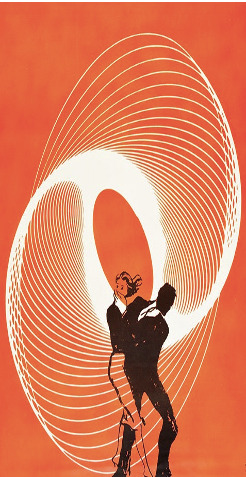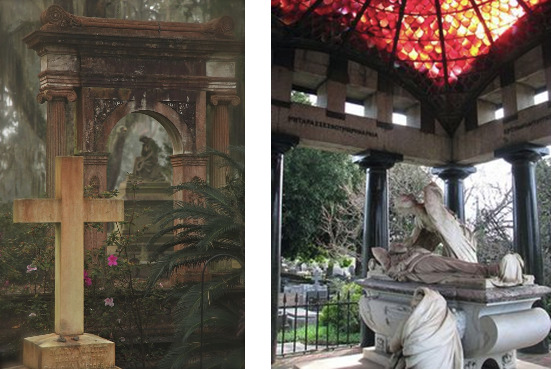Life & Island Times: Vertigo

Author’s Note: Thirty or so years ago, Savannah houses — many large and most of its small — were of stone and wood, shabby, run-down, some almost derelict. The occasional front or side yard was uncared for; most of the few people on the streets were cheaply dressed. There was a meanness of atmosphere.
Many large houses had seen grander days, yet obviously had become SRO apartment hotels.
The town’s heavily-canopied and overgrown graveyards darkened considerably early at this time of year with all human figures practically mere silhouettes among the unkempt plots and dirty and worn headstones.
There was an unspoken belief afoot in town that the town’s beautifully enmaddened ghosts came back from the dead, to take possession of the town’s unsuspecting visitors.
There was some mutuality afoot, some locals said.
The visitors gladly inherited these specters, who were once too old-fashioned to be of interest . . . until . . . they started trying them on, handling them gently, curiously as if staring at themselves and their inhabitants in the mirror . . . and going into the other’s world becoming someone else.
So, if you find yourself in a car headed south from downtown, in brilliant All Hallow’s Eve moonlight, and your auto enters an avenue of tall trees that you’ve seen before, beware if they suddenly look sinister in the moonlight.
Traveling faster will not help nor will looking up and ahead for some light at the distant end of the tunnel as the tall trees go flashing by in your headlights.
I promise you there are no tricks, just treats, in this brief tale.
-Marlow
Vertigo
Our first-floor front room library is fresh, light, and simple, and crowded with books, phonograph records and CDs, and pictures. Its striking feature is its floor to 10-foot-tall ceiling windows view of the Confederate Jasmine vine covered wrought iron fence and tree lined avenue.
On the walls opposite are old timey black and white images of family members stretching back more than a century. Their subjects can be seen concentrating with professional intensity on looking serious but not stern with few distinguishing features and dressed in simple business attire clothing. From their looks, these folks appear to be in their mid-thirties and eye glass wearers who do not dramatically whip them on and off as once was done in the movies. Their music came from a gramophone like the one that resides in that front room under the handsome photo of one of W’s great-greats. We suspect more than a few of those photo’d people wear wearing corsets — that would explain their pinched faces.
In this room we sit in a big, wing-backed, faded, red-clothe armchair with our feet stretched out on a matching ottoman with heads leaned slightly back when reading or in smaller simpler chairs when assembling 1000- or 1500-piece puzzles on the leafed central table under the room’s former gas lamp chandelier. In between the street windows is a fully stocked Art Deco-era bar.
Sometimes, especially after evening dinner, there’s a drink on the puzzling table. It aids our seeing the larger picture as we puzzlers seek and find the next bits and pieces to the larger solution.
What we’re going to do next each day now that we both are fully retired is an evolving and engaging daily series of shopping, meal planning-shopping-prepping-cooking, card playing, gardening, travelling, park walking, reading, writing, photographing, quilting, old album/CD or online music listening, restaurant dining, music venue enjoying, movie watching, friend/shut-in/doctor visiting, eating out, touring, dancing . . .
No fears of anything like height except for that of loss. Not a fear of losing it but that of friends and family. There is no way to stop or staunch that, but we’re not gonna sit all day in our armchairs. Out, about and engaged is where we belong.
We are ever grateful to be of fairly independent means and of mostly sound mind and body to avoid retirement blues and its crack ups. We like love living here — it has color, a powerful vibe and freedom. We don’t worry ourselves much with following distant disturbing things in the papers or new programs.
No vertigo Savannah style for us. Nor fears if someone from our long-ago pasts might re-enter our lives and take possession of our beings suddenly with current words and thoughts fading into silence, dark grey clouds coming into our eyes and them going blank . . . no, that’s for others.
We do not wander but walk the park, window shop Bull Street businesses and sit on Savannah square and, in particular, Forsyth Park benches around the edge of its famous fountain staring at its lovely water sprays and wildlife and cherub statues to the far shores and portals of the town’s and its people’s past.
We sometimes sit there a long time, hardly saying anything to one another other than to discreet point to something new and interesting that has caught their eyes, not having any reason to leave. Those evenings after we come home, we don’t look at our cell phone app pedometers to see how far we walked, knowing the short distances by heart. But when reviewing what we have seen, we know we have walked much more than a century and a half into the past and back.
We never know beforehand what to look for, even though we know the town so well — it always looks so lovely and normal . . . its shifitng moods and unchanging landscapes that take us back to Colonial, Revolutionary and Civil War days. This is the way Savannah is.
Our eyes search these scenes slowly, carefully, passing over the many casually dressed tourists and fancily attired wedding party members searching for the most perfect life photo backdrops. We more often than not get clear looks. We now take it for granted that Savannah deeply changes its visitors, beginning on the first day they arrive. We know what the town does to people who have never seen it before. It just happens but with a silent intensity as to be almost frightening.
They are like children under a Disney Magic Kingdom spell. The city excites them, inviting them to walk the parks and squares, downtown neighborhoods, explore out to Tybee Island’s ocean edges, see all its old houses and wander its old streets, and when they come upon things that have remained unchanged, their delight is so strong, so fiercely possessive that we see that these visitors feel these things are theirs, despite never having been there before. They love this place, as if they were born and raised here. This almost makes us a bit uneasy — their delight too strong, excitement too intense and long lasting, laughs too loud, and eyes sparkling too brightly. At times we sense a feverishness in the way these newbies embrace the city, as if possessing it or being possessed by it.
None of them have crazed looks . . . young or old — all have eyes that have warmth and intelligence and humor with a sure, distant repose.
In Savannah’s historic cemeteries, we rest seated on small wooden or stone benches at the far end of the graveyard rows with enigmatic smiles observing these transubstantiations.

Small chapel arches in old Savannah cemetery. Not very dark except
for the strong dusk light at the end chapel on left where its altar space was.
Visitors are often spotted gazing down at headstones missing the dried out posey buds scattered here and there whose long ago vibrant green stems were clutched in small white gloved hands whose holders were not seeing behind and among these stones beyond their small, bowed heads, eyes still looking at the freshly dug hole.
We are in our seventh year of Savannah residence. We are two of its Watchers.
Copyright 2022 My Aisle Seat
www.vicsocotra.com
